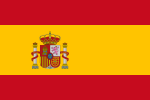Santiago Ramón y Cajal (Spanish: [sanˈtjaɣo raˈmon i kaˈxal]; 1 May 1852 – 17 October 1934) was a Spanish neuroscientist, pathologist, and histologist...
46 KB (5,154 words) - 13:45, 19 October 2024
Argentine boxer Santiago de la Parte, Spanish long-distance runner Santiago Phelan, Argentine rugby player and coach Santiago Ramón y Cajal, Spanish neuroscientist...
6 KB (695 words) - 18:14, 28 September 2024
largely consist of proteins and RNA. They were first reported by Santiago Ramón y Cajal in 1903, who called them nucleolar accessory bodies due to their...
8 KB (1,020 words) - 17:39, 12 July 2024
postnatal life. These cells were discovered by two scientists, Santiago Ramón y Cajal and Gustaf Retzius, at two different times and in different species...
28 KB (3,481 words) - 08:13, 1 September 2024
Golgi method. Golgi staining was used by Spanish neuroanatomist Santiago Ramón y Cajal (1852–1934) to discover a number of novel facts about the organization...
6 KB (632 words) - 04:28, 12 May 2024
Alfonso XIII on the occasion of the Moscow Prize to Santiago Ramón y Cajal (1852–1934). Following Cajal's award of the Nobel Prize in Physiology and Medicine...
6 KB (489 words) - 11:25, 26 June 2024
work of the Spanish anatomist Santiago Ramón y Cajal. To make the structure of individual neurons visible, Ramón y Cajal improved a silver staining process...
79 KB (9,153 words) - 22:48, 18 October 2024
intestinal pseudo-obstruction. The interstitial cells of Cajal are named after Santiago Ramón y Cajal, a Spanish pathologist and Nobel laureate. List of human...
9 KB (1,045 words) - 11:20, 11 September 2024
individual cells, a discovery due to decisive neuro-anatomical work of Santiago Ramón y Cajal and later presented by, among others, H. Waldeyer-Hartz. The term...
10 KB (1,368 words) - 17:30, 11 April 2024
Physiology or Medicine was awarded to histologists Camillo Golgi and Santiago Ramon y Cajal. They had conflicting interpretations of the neural structure of...
33 KB (3,195 words) - 17:37, 18 October 2024
laureate Santiago Ramón y Cajal. It is a circular (9 km diameter), cup-shaped formation that lies southeast of the lava-inundated crater Jansen. Cajal was...
4 KB (304 words) - 15:45, 22 August 2024
The Hospital Universitario Ramón y Cajal is a public general hospital located in the Valverde neighborhood, in Madrid, Spain, part of the hospital network...
4 KB (419 words) - 09:55, 21 August 2024
organ and the Golgi tendon reflex. Golgi and the Spanish biologist Santiago Ramón y Cajal were jointly given the Nobel Prize in Physiology or Medicine 1906...
29 KB (3,407 words) - 14:45, 15 August 2024
The Ramón y Cajal Scholarship (RyC) is a Spanish post-doctoral scholarship, funded by the Spanish Ministry of Science, that allows outstanding early career...
12 KB (1,185 words) - 02:04, 21 July 2024
Cajal: Santiago Ramón y Cajal, Spanish histologist, physician, pathologist Fortún Garcés Cajal, medieval Spanish nobleman Nicolae Cajal (1919–2004), Romanian...
517 bytes (85 words) - 23:32, 1 May 2016
features are now commonly referred to as the Nodes of Ranvier. Santiago Ramón y Cajal, a Spanish anatomist, proposed that axons were the output components...
24 KB (2,885 words) - 12:11, 30 September 2024
infection. Pyramidal neurons were first discovered and studied by Santiago Ramón y Cajal. Since then, studies on pyramidal neurons have focused on topics...
25 KB (2,394 words) - 13:45, 2 September 2024
theory was refuted by later observations of Spanish pathologist Santiago Ramón y Cajal, using a staining technique discovered by Golgi, which showed that...
7 KB (900 words) - 17:20, 1 July 2024
intricate structures of individual neurons. His technique was used by Santiago Ramón y Cajal and led to the formation of the neuron doctrine, the hypothesis...
97 KB (7,444 words) - 22:49, 18 October 2024
precise neurotransmitters release control system. Camillo Golgi and Santiago Ramón y Cajal (1906) for the development of the silver staining method, revealing...
30 KB (2,919 words) - 14:48, 16 August 2024
doctorate and helped establish neuron doctrine. Later, neuroscientist Santiago Ramón y Cajal won the 1906 Nobel Prize in Medicine for his research on the same...
98 KB (11,904 words) - 20:57, 1 September 2024
Axial twist theory (section Cajal's visual map theory)
19th century, the famous neuroscientist and Nobel prize winner Santiago Ramón y Cajal proposed a theory to explain the contralateral organization of the...
42 KB (4,550 words) - 18:51, 17 October 2024
form in the absence of new neurons. The Spanish neuroanatomist Santiago Ramón y Cajal was among the first to suggest a mechanism of learning that did...
61 KB (7,328 words) - 18:22, 12 August 2024
inside the brain. Already in the late 19th century theorists like Santiago Ramón y Cajal argued that the most plausible explanation is that learning and...
132 KB (15,615 words) - 14:36, 18 October 2024
Their existence was originally proposed by Spanish histologist Santiago Ramón y Cajal based upon stationary images he observed under the microscope. He...
15 KB (1,695 words) - 15:26, 29 September 2024
Jeremy R. Knowles Professor of Molecular and Cellular Biology and Santiago Ramón y Cajal Professor of Arts and Sciences at Harvard University. He is best...
11 KB (880 words) - 17:07, 5 October 2024
parapsychology"; J. J. Thomson, who was interested in psychic phenomena; Santiago Ramón y Cajal, who wrote a book "on hypnosis, spiritualism, and metaphysics";...
17 KB (1,837 words) - 18:12, 18 October 2024
dendrites also synapse with distinctive unmyelinated axons which Santiago Ramón y Cajal called mossy fibers Mossy fibers and golgi cells both make synaptic...
27 KB (3,175 words) - 15:44, 24 July 2024
laureate Santiago Ramón y Cajal. In 1923, he went to the University of Madrid Medical School, where he hoped to work with Ramón y Cajal, but Ramón y Cajal retired...
16 KB (1,555 words) - 16:39, 16 October 2024
sailor, designer of the first fully operative military submarine Santiago Ramón y Cajal (1852–1934), father of Neuroscience, Nobel prize laureate (1906)...
78 KB (7,046 words) - 15:47, 19 September 2024




















